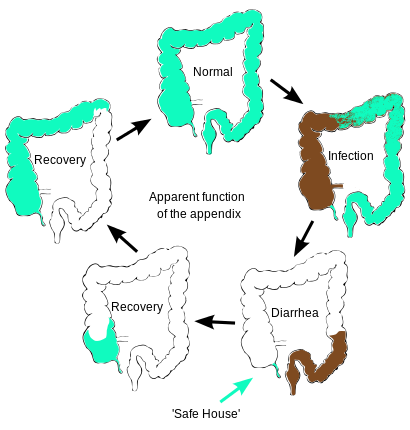File:Appendix function diagram.svg

Original file (SVG file, nominally 410 × 430 pixels, file size: 82 KB)
This file is from Wikimedia Commons and may be used by other projects. The description on its file description page there is shown below.
Summary
| DescriptionAppendix function diagram.svg |
English: Conversion to SVG format of existing diagram in JPG format.
Original author Apparent function of the human vermiform appendix in the recovery from diarrhea. (J. Theoretical Biology. doi:10.1016/j.jtbi.2007.08.032) The colon with normal, beneficial bacteria (green color) is contaminated with an organism (brown color) that causes diarrhea. The appendix apparently serves as a "safe house" for the good bacteria, protecting that supply of bacteria from contamination and facilitating a re-start of the system once the contaminating organism has been eliminated. (J. Theoretical Biology. doi:10.1016/j.jtbi.2007.08.032) Although more than 2 million children die each year in developing countries as a result of diarrhea, children living in those countries face an estimated 1.4 billion cases of diarrhea each year (Information based on data from the Centers for Disease Control and Prevention (CDC) as published in Emerg Infect Dis 9(5), 2003.) Thus, the process of recovery from diarrhea is relatively effective in developing countries. This process is expected to be less critical in developed countries, where widespread epidemics resulting in diarrhea are uncommon and thus the loss of beneficial bacteria from the population as a whole is highly unlikely. (J. Theoretical Biology. doi:10.1016/j.jtbi.2007.08.032) SummaryConversion to SVG format of existing diagram in JPG format. Original author Explanation |
| Date | |
| Source | Own work |
| Author | WebHamster (talk) (Uploads) |
Licensing

|
Permission is granted to copy, distribute and/or modify this document under the terms of the GNU Free Documentation License, Version 1.2 or any later version published by the Free Software Foundation; with no Invariant Sections, no Front-Cover Texts, and no Back-Cover Texts. A copy of the license is included in the section entitled GNU Free Documentation License.http://www.gnu.org/copyleft/fdl.htmlGFDLGNU Free Documentation Licensetruetrue |
- You are free:
- to share – to copy, distribute and transmit the work
- to remix – to adapt the work
- Under the following conditions:
- attribution – You must give appropriate credit, provide a link to the license, and indicate if changes were made. You may do so in any reasonable manner, but not in any way that suggests the licensor endorses you or your use.
- share alike – If you remix, transform, or build upon the material, you must distribute your contributions under the same or compatible license as the original.
Original upload log
| Date/Time | Dimensions | User | Comment |
|---|---|---|---|
| 2010-06-13 16:02 | 414×418× (210134 bytes) | Joshua Issac | Decrease file size by deleting useless invisible parts of the image. |
| 2010-06-13 15:52 | 414×418× (214167 bytes) | Joshua Issac | Correct inaccuracy. |
| 2008-06-26 05:59 | 414×418× (212298 bytes) | Iain | Removed massive amounts of redundant infomation from SVG file. |
| 2008-01-10 17:34 | 414×418× (4987828 bytes) | WebHamster | Conversion to SVG format of existing diagram in JPG format. Original author {{User|Bparker737}} Apparent function of the human vermiform appendix in the recovery from diarrhea. (J. Theoretical Biology. doi:10.1016/j.jtbi.2007.08.032) The colon with norma |
Captions
Items portrayed in this file
depicts
10 January 2008
image/svg+xml
765662f0b5841e0cfff91fe075b349363e018fa3
84,293 byte
430 pixel
410 pixel
File history
Click on a date/time to view the file as it appeared at that time.
| Date/Time | Thumbnail | Dimensions | User | Comment | |
|---|---|---|---|---|---|
| current | 03:00, 7 November 2014 |  | 410 × 430 (82 KB) | wikimediacommons>OgreBot | (BOT): Reverting to most recent version before archival |
File usage
The following page uses this file:
Metadata
This file contains additional information, probably added from the digital camera or scanner used to create or digitize it.
If the file has been modified from its original state, some details may not fully reflect the modified file.
| Width | 410 |
|---|---|
| Height | 430 |